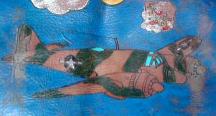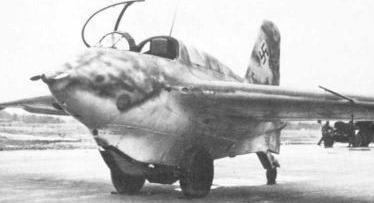A microfilm roll containing the unit history and war diaries of the 415th night fighters squadron in the archive of the U.S. Air Force contains several Foo Fighters incidents reports, including the on over Hagenau in 1944. This is the primary source for this incident [usa]. It says:
War Diary Page 2 December 1944
S E C R E T
WAR DIARY
415 NIGHT FIGHTER SQUADRON
OCHEY AIR BASE, FRANCE
DECEMBER 1944
23 More Foo-Fighters were in the air last night. The Ops.
Report says: "In vicinity of Hagenau Saw 2 lights coming
Toward A/C from ground. After reaching the altitude of the
A/C they leveled off and flew on the tail of Beau for 2 minutes
And they peeled up and turned away. 8th mission - sighted
2 orange lights. One light sighted at 10,000 the other
climbed until it disappeared.

|
Above:Jacket badge of the US 415th night fighters squadron, showing the British Bristol Beaufighter plane they were using then.
Jo Chamberlin, in a 1945 article on the Foo Fighters published in the American Legion Magazine, provides what is the first secondary source [cha]:
"On December 22-23, 1944, another 415th night fighter squadron pilot and radar-observer were flying at 10,000 feet altitude near Hagenau. "At 0600 hours we saw two lights climbing toward us from the ground. Upon reaching our altitude, they leveled off and stayed on my tail. The lights appeared to be large orange glows. After staying with the plane for two minutes, they peeled off and turned away, flying under perfect control, and then went out."
"The next night the same two men, flying at 10,000 feet, observed a single red flame. Lt. David L. McFalls, of Cliffside, N. C., pilot, and Lt. Ned Baker of Hemat, California, radar-observer, also saw: "A glowing red object shooting straight up, which suddenly changed to a view of an aircraft doing a wing-over, going into a dive and disappearing." This was the first and only suggestion of a controlled flying device."
The case later entered UFO literature.
Harold T. Wilkins, in his book "Flying Saucers On The Attack" [wil] indicates that on December 22, 1944, Lieutenant David McFalls of Cliffside in Northern Carolina and radar operator Edward Baker of Hemat in California flew south of Hagenau, 32 kilometers north of Strasbourg and 26 kilometers west of the river Rhine.
He gives the following description of how the lights appeared, by pilot Lieutenant David McFalls:
"At 0600 hours [06:00 a.m.] we saw two lights climbing toward us from the ground. Upon reaching our altitude, they leveled off and stayed on my tail. The lights appeared to be large orange glows. After staying with the plane for two minutes, they peeled off and turned away, flying under perfect control, and then went out."
German ufologist Illobrand von Ludwiger used the case as reported by Wilkins in an article on Foo Fighters [bra].
Patricia Hervias writes in an article published on the Internet [her]:
December 22, 1944: "Close to Hagenau, at ten thousand feet altitude, two large and brilliant lights of orange color rose at a great speed from the ground towards us. At our level, they followed our plane during approximately two minutes. It appeared to us that they were under a perfect control (terrestrial operators). While they moved away, their fire appeared to die out."
This was the concise report by McFalls and Backer, members of the 415th squadron of the United States, the first to break the forced silence around the appearance of strange flying lights. Many descriptions like this one were made during the World War II, thus prompting the name of Foo Fighters (fighters of fire).
Seemingly the report by Wilkins also appears in Fortean Studies #7 [fs7] and in "Mysteries of the Skies: UFOs in Perspective", by Gordon Lore and Harold Deneault [lor], and several other ufology sources [see sources section.]
In the Condon Report [con], Martin D. Altschuler says that Foo Fighters were St Elmo fire. However, it cannot be the correct explanation for this case, it is enough to read what St. Elmo fire are in Altschuler's text or elsewhere to realize that it does not appear as large orange light, does not climb from the ground towards planes, does not follow planes and does not fly away after two minutes. Other plasma phenomena such as ball lighting also do not apply.
To me, the crew's description of the actions of the orange light cannot match a natural phenomenon. The possibility that immediately comes to mind is another aircraft.
This idea is reinforced in the fact that the same crew reported another flame of red light, the following night, and added that when this other light turned, is "appeared in the shape of an aircraft."
In this context, and with the brevity of the original report, it is not unreasonable to consider that the crew was really thinking that they observed some sort of airplane. A UFO or flying saucer context did not exist to them, so a report and description of a light would not comprise any elements that would suggests they did not think it was some sort of aircraft of human construction.
It is also apparent that no extraordinary manoeuvers are reported except of the initial climb. As the orange lights follow the plane for two minutes, only classic aircraft speed seems at work, maybe faster however than the Beaufighter's speed.
If the light was an aircraft, it however cannot have been a very familiar aircraft, otherwise the crew would have given some sort of identification of it. It cannot be a very conventional enemy plane, or an enemy aircraft in close vicinity, because a dogfight would have likely resulted from the encounter.
It does appear that the crew did not think it was an ordinary aircraft and they did not react as they probably would have if they had thought that it can be an enemy aircraft. The report would nave have started with a sentence such as "More Foo-Fighters were in the air last night."
So I wondered whether they could have encountered some unarmed or non-efficient new German aircraft that would emit an unusual amount of light so that it appears as an orange light, and climb fast and rather straight up.
By looking at Foo Fighters reports in general, it is apparent that most of it is no aircraft at all. But this does not mean that all Foo Fighters reports are not aircraft. Some could be, especially those seen at night - as this sighting occurred when the sky was dark.
Messerschmitt 163 "Komet", as its name suggests, would indeed be a luminous gleam at night: it was the first rocket plane used in air battles in the world. It reaches 9000 meters of altitude in 2 minutes, or 12000 meters in 3 minutes, can still operate 3 to 4 minutes, and when the fuel is exhausted, the rocket is off and it glides down.

|
Above A Me-163 is shown at the USAF Museum at Dayton, Ohio, USA, another is shown at London's Science Museum, U-K.
From February 1944, Komet were precisely built in the Black Forest, not far from the place of this observation. In July 1944, 16 Komet are operational, their number would increase to 250 at the end of the 1944. Though a brilliant idea, the plane was a disaster in operation, with 80% of them destroyed in explosions of its dangerous fuel on the ground. The pilots damaged their spine at the time of takeoffs. The interceptions of bombers did not go well because the Komet was much faster, and they were often destroyed by P-51 Mustang fighters that protected the bombers once they started to glide down at a lower speed. While more than 400 Komet were built, they only shot down 9 allied bombers, which made Komet one of the less efficient combat plane ever built.
In theory, Me-163 Komet flew by day and not by night. But there is nothing impossible with such an attempt. Although nothing makes this explanation certain, it is not impossible that the Beaufighter's crew saw two Me 163 of the nearby factories making a flight by night test.
It is a pity that no data from the Beaufighter's airborne radar is provided. Me 163 was capable of flying at 979 km/h, a speed beyond comprehension for US pilots at that time. But if radar clocking indicated more than this speed, the Komet could have been rejected as cause. Possibly, such data still sleeps in the US archive.
The reported manoeuvers are quite compatible with those of Komets: it comes from the ground, levels, turns away, and the rocket is off so the light turns off.
* indicates sources that I own or checked, the '?' indicates sources that I have not been able to read yet.